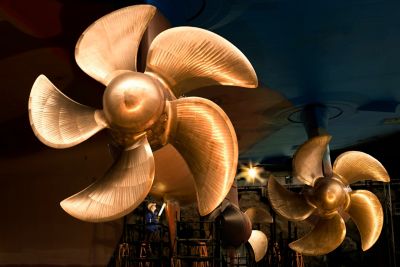Select region & language
- Europe
- Americas
- Middle East & Africa
- Asia & Oceania
Global
Austria
Bulgaria
Croatia
Czech Republic
Denmark
Estonia
Finland
France
Germany
Greece
Hungary
Ireland
Italy
Latvia
Lithuania
Luxembourg
Netherlands
Norway
Poland
Portugal
Romania
Serbia
Slovakia
Slovenia
Spain
Sweden
Turkiye
United Kingdom
Global
Argentina
Aruba
Bolivia
Brazil
Chile
Colombia
Costa Rica
Dominican Republic
Ecuador
El Salvador
Guatemala
Honduras
Mexico
Panama
Paraguay
Peru
Puerto Rico
United States of America
Uruguay
Global
Bahrain
Israel
Jordan
Kuwait
Lebanon
Oman
Pakistan
Palestine
Qatar
Saudi Arabia
South Africa
United Arab Emirates
Global
Australia
Bangladesh
India
Indonesia
Japan
Kazakhstan
Malaysia
New Zealand
Philippines
Singapore
South Korea
Sri Lanka
Taiwan (Chinese Taipei)
Thailand
Vietnam

Azipod® propulsion: 30 facts for 30 years
When ABB’s Azipod® system was launched 30 years ago, it marked a new era in vessel propulsion. After three decades, the technology is still breaking ground. Here are 30 facts to celebrate each year of Azipod® technology’s success. How many did you know?
1. Since launch, Azipod® propulsion units have collectively logged over 20 million running hours – equivalent to 2,283 years.
3. For each project, ABB designs a propeller tailored to the specific needs of the ship it will power.
4. Today, over 25 different vessel types rely on Azipod® technology – from cruise and passenger vessels to cargo ships, icebreakers and superyachts.
5. The largest cruise ship in the world – Symphony of the Seas – is equipped with three 20-megawatt Azipod® units – enough to power 500 cars.
7. Azipod® propulsion is proven to cut fuel consumption by up to 20 percent compared to traditional shaftline propulsion systems.
8. Azipod® propulsion has saved an estimated 1 million tons of fuel in the cruise segment alone.
9. Using Azipod® propulsion, a huge cruise vessel can be maneuvered with incredible precision and accuracy. Even the largest of ships can dock in harbors where turning circles are restricted.
10. Some of the largest Azipod® units weigh more than an adult blue whale – yet their ability to rotate 360 degrees makes the ships they steer much more maneuverable!
11. Vessels featuring Azipod® propulsion are safer: unlike ships using conventional shaftline system, they can be steered throughout the ‘crash stop’ period and take 50 percent less time to come to a complete stop.
12. The first-ever Azipod® unit was developed for and installed on an ice-going vessel.
14. The first tanker to cross the Northern Sea Route without the aid of an icebreaker was LNG carrier Christophe de Margerie – powered by Azipod® propulsion.
15. To break ice in particularly challenging conditions, vessels powered by Azipod® propulsion navigate stern first. Propellers mill the underwater part of the ice ridge to open a passage: water flow generated by the propeller flushes the hull, allowing the ship to move ahead with ease.
16. Norwegian Coast Guard’s vessel KV Svalbard has become the first ship powered by Azipod® propulsion to reach the North Pole in August 2019.
17. Since a vessel with the Azipod® system has no propulsion motor on board, there is extra space for passengers, cargo and storage.
18. The Azipod® system’s pioneering design minimizes noise and vibrations, ensuring a smoother, quieter ride for passengers and crew.
19. Vessels with Azipod® propulsion have been built at shipyards in 18 countries.
20. With a much simpler setup than conventional systems, Azipod® propulsion does not require a separate shaftline, rudder, stern thrusters or associated auxiliary systems.
21. Arriving at the shipyard fully assembled and ready for installation, an Azipod® unit is simply plugged straight into the vessel’s hull.
22. A large passenger vessel can take over two years to build – but the Azipod® propulsion system can be mechanically fitted in a matter of days.
23. Shipyards often install the Azipod® system just a week or two before the vessel is launched.
25. A vessel can be powered by just one Azipod® unit – or as many as eight and even more.
26. The world’s largest civilian hospital ship is powered by Azipod® propulsion.
27. Azipod® propulsion is a future-proof system: it can be powered by electricity drawn from various energy sources, including renewables, and can easily adapt to new sources – potentially even those yet to be developed.
28. Azipod® units are produced at three locations: propulsion and steering units for the largest models are manufactured at factories in Helsinki and Hamina, Finland, while compact units are constructed at a facility in Shanghai, China.
30. Azipod® units are now available in the power range of 1 to 22 megawatts.